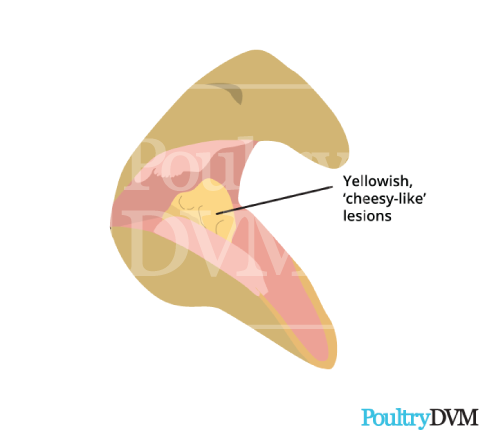Veterinary advice should be sought from your local veterinarian before applying any treatment or vaccine. Not sure who to use? Look up veterinarians who specialize in poultry using our directory listing. Find me a Vet
Other Names: Canker, Frounce, Trichomoniasis

| Candidiasis (Thrush) | Canker | |
|---|---|---|
| Body areas affected | Oral cavity, esophagus, and crop | Oral cavity, esophagus, and crop |
| Pathogen type | Yeast | Protozoan parasite |
| Pathogen species | Candida albicans | Trichomonas gallinae |
| Oral lesion appearance | Patches of raised, whitish, dead epithelial debris. The top white pseudomembranes can be wiped off. | Sticky, yellowish-white 'canker-like' masses of caseous, necrotic material. |
| More likely to occur following | Prolonged antibiotic therapy, concurrent disease, infestation with internal or external parasites, or stressful event. | Pigeons and doves sharing the same water or feed source. |
| Treatment | Nystatin, copper sulfate | Metronidazole, thyme extract |
| Name | Summary | |
|---|---|---|
| Supportive care | Isolate the bird from the flock and place in a safe, comfortable, warm location (your own chicken "intensive care unit") with easy access to water and food. Limit stress. Call your veterinarian. | |
| Surgery | Diphtheritic plaques in the chicken's mouth may need to be removed by debridement. | |
| Carnidazole | Given once orally at 50 mg/kg. | B Speer |
| Metronidazole | Given twice a day orally at 10-30 mg/kg or added to flock drinking water at 100-200 mg/L for 7 days. | B Speer |
| Toltrazuril | Given once orally at 50 mg/kg or added to flock drinking water at 25 mg/L for 2 days. | B Speer |
| Thyme (Thymus vulgaris) extract | Administered orally | NT Nasrabadi et al., 2012 |
| Garlic (Allium sativum) | Administered in drinking water (200 mg/kg, once a day for one week) | Seddiek ShA et al., 2014 |
| Berimax | A highly effective alkaloid nutraceutical derived from purified plant extracts by a Norwegian veterinarian. | |
| Antibiotics | May be required in cases of secondary infections. |

| Winter | Spring | Summer | Autumn |
© 2025 PoultryDVM All Rights Reserved.